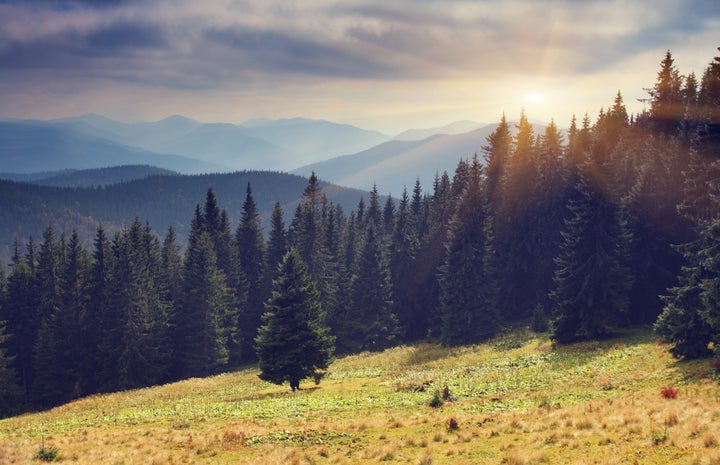
We have been aware for a long time that landscape, the natural world, deeply affects many individual writers and artists. Very often it is the landscape of childhood that imprints itself indelibly on the creative imagination, although there are exceptions.
A newer question though is whether landscape shapes, or more modestly perhaps becomes one of the things that shapes, whole cultures, their languages, their religion and their mythology; and of course therefore their responses to their artists and artistic forms. Is it by chance that the great monotheisms emerged from the desert? That perhaps the most pessimistic theology I know of, that of the Norse gods, developed in the place of the longest darkest winters? That, in the wildly diverse broken landscapes of the Mediterranean islands, Greek mythology has characters constantly metamorphosing into something else -- animals, stars or Gods? Or that, in Northern European fairy stories (like the Grimm Brothers' collections), forests are the place of both peril and triumph over adversity?
From the mid-nineteenth century, when people got interested in fairy stories and folk tales again, until recently there was a strong tendency to look for what folk stories had in common, to create generalised taxonomies which ended up with ridiculous truisms like "there are only 6 stories in the world" and with a frequently reductionist psychoanalytic reading of all of them.
But if nature informs the imagination and generates creativity this is not good enough. No one thinks that all landscapes are somehow identical, so why should the stories be? Perhaps we need to dig a little deeper and look at what is different and specific about the various bodies of folk lore that we have available. In this respect English-speakers are privileged because we have two equally ancient, comparatively well recorded and richly extensive indigenous folk traditions: the Celtic stories and the Teutonic (or Germanic) stories and they come from very different landscapes.
The typical protagonist of a Celtic story is male, usually comes with a long and noble pedigree, is trained in childhood for his destiny, and lives under a strong fate. He often travels far from home and engages in epic battles -- with himself, with human adversaries and with huge forces, often magical. Love carries a high risk of tragedy and death is a frequent outcome. The typical protagonist of a Teutonic story is of either sex, nameless (or has a generalised or descriptive name "John" or "Snow White"), is far more domestic and ordinary and usually much more "lower class." (We get confused on this point because we increasingly preferred the stories about Princes and Princesses (29 out of 210 stories in the Grimm's' 1857 collection) to those about soldiers, tailors, peasants and unspecified poor people (97 stories)) All the Teutonic stories are short and end happily.
One of the most obvious differences is in how magic works. In the Celtic tradition magic is a very big deal - it has cosmic significance and is highly perilous to the individual. It requires long training, immense self-discipline and considerable sacrifice. Most "good" magicians are male and solitary; a great deal of magic leads to unhappiness, inappropriate love relationships and separation from the community. (This tends to be the model we have adopted currently - the line from Merlin to Harry Potter, with Gandalf and Ged along the the way, is very clear.) Teutonic magic is the opposite; it is casual, minor, unearned and chancy. No one learns how to do it; they are just given magical gifts which they can use to their advantage. You are an embittered old soldier, you come along a road through the forest and an old lady gives you a "little cloak of invisibility" for no reason whatsoever; you use it to win a princesses and half a kingdom -- lucky you.
I have become convinced, through my own responses to being in varying landscapes as well as through reading, that the difference here is about nature and, in this case, how far you can see. The Celtic stories emerge from coasts and islands, where you can know what is coming and where you might be going for a long, long time. You can see the whole sky and watch the stars across it and read enormous stories into their slow passing. And sea journeys are actually dangerous; when you sail away you may never come home -- you need skill and training and huge ambition even to attempt it.
In the forests of northern Europe the situation is different: you can get lost because you cannot orientate yourself by the sun or the horizon, but equally you can hide. The outlaw and the runaway and the child have somewhere to go, to become invisible and free. Only yards from you there may be a robber waiting to pounce, or there may be a delicious clump of chanterelle mushrooms which were not there last week. This nasty little grub suddenly turns into a butterfly. It took until the nineteenth century for people to be fully persuaded that swallows really migrated rather than hibernating in ponds -- because one day they were there and then they were not. Naturally these stories are full of secrets and surprises and straightforward good luck.
Nature informs the stories and the stories inform what we see in nature -- the seashore is "bracing", the forests are "mysterious". Nature and fairy stories have a symbiotic relationship that we lose, I believe, at our peril. There is a danger in teaching children "ecology" unless it is backed up by specific local hands-on "nature study." Our imaginations are formed by our experiences -- both cultural and natural, because they are basically one and the same.
Sara Maitland is the author of From the Forest: A Search for the Hidden Roots of our Fairy Tales.